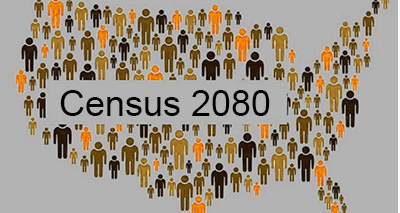‘Estimates Look Bad but Reality Will Be Far Worse’
- Post AuthorBy Peter Bradley
- Post DateFri Oct 29 2021
“The estimates look bad, but the reality will be far worse.” This subtitle from the April 1983 cover story of Instauration is probably the most succinct summary of that publication’s 25 year history. It is also an accurate description of the American racial situation for at least the last 60 years. The article it comes from is “The Future Racial Composition of the United States,” and is a review of a 1982 publication of the same name by demographers Leon Bouvier and Cary Davis. The unsigned article — probably written by Instauration editor Wilmot Robertson — begins bluntly:
The Bouvier Report, ‘The Future Racial Composition of the United States,’ should bear the same warning label seen on some roller-coaster ticket windows: ‘Not recommended for heart patients’ (at least, not for white ones). Veteran demographer Leon F. Bouvier and his coauthor, Cary B. Davis, have calculated that, if present population trends continue — and currently there is no political force on the horizon to stop or reverse them — the U.S. in 2080 will be only 43.5% “White non-Hispanic,” a catch-all group which even includes American Indians. As for California, even if national immigration levels are reduced considerably from what they have been these last few years, the Golden State will be only 28.8% “White non-Hispanic” in 2080.
The 2020 U.S. Census results were released in August and prove that the subtitle of the Instauration article was accurate. Whites are a mere 57.8 percent of the U.S. population, down from about 64 percent in 2010. That 43.5 percent in 2080 projection is looking awfully optimistic. How about California? In 2020 it was 36.5 percent white. Instauration called it correctly:
The reality is that California will be perhaps 10% “White non-Hispanic” in 2080, and that 10% will be concentrated in the northern redwood country and other peripheral areas. In the big cities, European racial types will be perhaps 2% or 3%, if they survive at all — just as the English Americans who settled New England (and constituted 90% of its population in 1840) are now 2% and 3% in some of its cities.
Instauration also asks why Mr. Bouvier, supposedly an expert on race and demographics, counts American Indians as white? His only explanation was that it seemed “inappropriate” to label the “earliest Americans as ‘other.’”
A white man?
This is how Mr. Bouvier introduces his subject: “Since Independence, the ethnic and racial composition of the United States has resembled a constantly changing kaleidoscope reflecting the varying sources of immigration as well as the fertility and mortality of both natives and immigrants.”
Instauration wants to know:
Why start at Independence? In fact, North America was racially mostly Indian until the 1600s, when it became mostly Nordic, which it remained until quite recently. The United States was overwhelmingly British in 1840, and overwhelmingly white until after President Johnson’s Immigration “reform” bill of 1965. The “constantly changing kaleidoscope” is a very new reality, at least on the racial level (and this purports to be a study of race): nonetheless, it has already become a national myth, and one to which Bouvier and Davis feel they must make an opening obeisance.
The article goes on to note the faulty logic of “The Future Racial Composition of the United States.” Legal immigration has gone up, not down; illegal immigration remains high (the border is as porous under Joe Biden as it has ever been); white fertility has decreased (1.758 in 1980 and 1.64 in 2019). Also, growing numbers of non-whites mean more interracial marriage and multiracial children — and fewer white children. This helps explain why the number who claim to be multiracial doubled from 2010 to 2020.
If all that the Instauration article did was pick apart a shoddy study, it would still be well worth even if only for such lines as:
“That is the bad news. There is no good news. There is only worse news.”
“I choked when I read this.”
“Where, pray tell, will those pure-white Swedes of 2080 be coming from? Off an asteroid?”
“We have barely skimmed the surface silliness from the fathomless folly of Leon F. Bouvier and Cary B. Davis.”
Instauration pointed out that almost all racial demographic calculations understate the rate at which whites are being replaced. It wasn’t that long ago that we were told 2050 was the year whites would become a minority. More recently, it was changed to 2042. Given the rate of white decline and the very real potential of amnesty for illegals and increased legal immigration, it may well be 2030.
Instauration also points out the effects of multi-racialism on the white birthrate:
The fact is that white fertility is generally lowest in precisely those places where whites must now compete with nonwhites: in California, the urban North, and — what is seldom realized — in the post-Martin Luther King South as well. The remaining pockets of higher white fertility are generally in the Mountain states and in the rural Midwest. For example, Iowa, with few blacks, had a birthrate in 1981 of 16.1 per 1,000 people, while the Virginia rate was only 14.0 per 1,000, although the latter state has a large black minority with a high birthrate. It’s easy to see that not many whites are being born in Virginia.
The reason racial integration depresses white fertility is that virtually all white people are crypto-“racists.” Even the ones who most loudly profess liberalism are determined that their son and their daughter will not attend mostly non-white schools, or, worse yet, work in jobs largely taken over by blacks and Hispanics. In 1983, a white dishwasher or ditch-digger in Iowa had considerably more status than one in Virginia. An Iowa schoolteacher or hairdresser was not in a profession dominated by non-whites, either. Iowans of every social class might “take a chance” on a third or fourth child, even though they knew they could “not do as well by him.”
As Instauration noted: “In the South, even the earliest rumors of integration back in 1954 depressed the white birthrate relative to the nation as a whole. As racial mixing becomes far more pervasive nationwide in the decades ahead, we can certainly expect whites to persist in their suicidal fertility practices.”
Instauration also warned of the impact of mass non-white immigration on politics. This may have been one of the earliest warnings to Republicans, who have been swept away electorally in many states by diversity:
It’s time we started figuring the impact of all this on our electoral college system. Florida and Texas, plus California, New York and Illinois (for starters) will all have nonwhite majorities well within a century. With Hawaii and the District of Columbia, they had 164 electoral votes in 1980. If a presidential candidate carried the rest of the nation by a 268-106 electoral landslide but lost to the bloc-voting minorities in just those states, he would lose nationally by 270-268.
The Bouvier report did attract some media attention at the time, including from one of the most widely read conservative columnists of that era, James J. Kilpatrick. Kilpatrick was a former segregationist who shifted his views in the mid-1960s to keep his syndicated column. He was rewarded handsomely. In 1980, he was carried in 538 newspapers and enjoyed an annual income of $150,000.
James J. Kilpatrick
Instauration noted how far “the onetime preacher of Southern resistance” had fallen: “Take James J. Kilpatrick, who, upon learning that ‘whites’ would be a minority in 2080, asked, ‘Does it matter?’ and glibly answered ‘no.’” The article also mocked Kilpatrick, who, “writes fashionably (if crazily): ‘My own guess . . . is that the next 20 or 30 years are more likely to see political divisions along the lines of age and sex than along the lines of race and color.’ Now you know why they let him on national TV!”
If Kilpatrick were alive, he would feel right at home at National Review or The American Conservative.
It is hard to argue with Instauration’s conclusion:
Oblivion is the true name of the white American game. After all, a far lower average level of immigration and a far higher national average level of native fertility than those now prevailing sufficed to drive New England’s colonial stock to the brink of extinction. If white America as a whole cannot learn from that somber regional experience, and act upon its learning, it deserves the grave already being dug for it.
We must learn our lessons better during the next 40 years.


